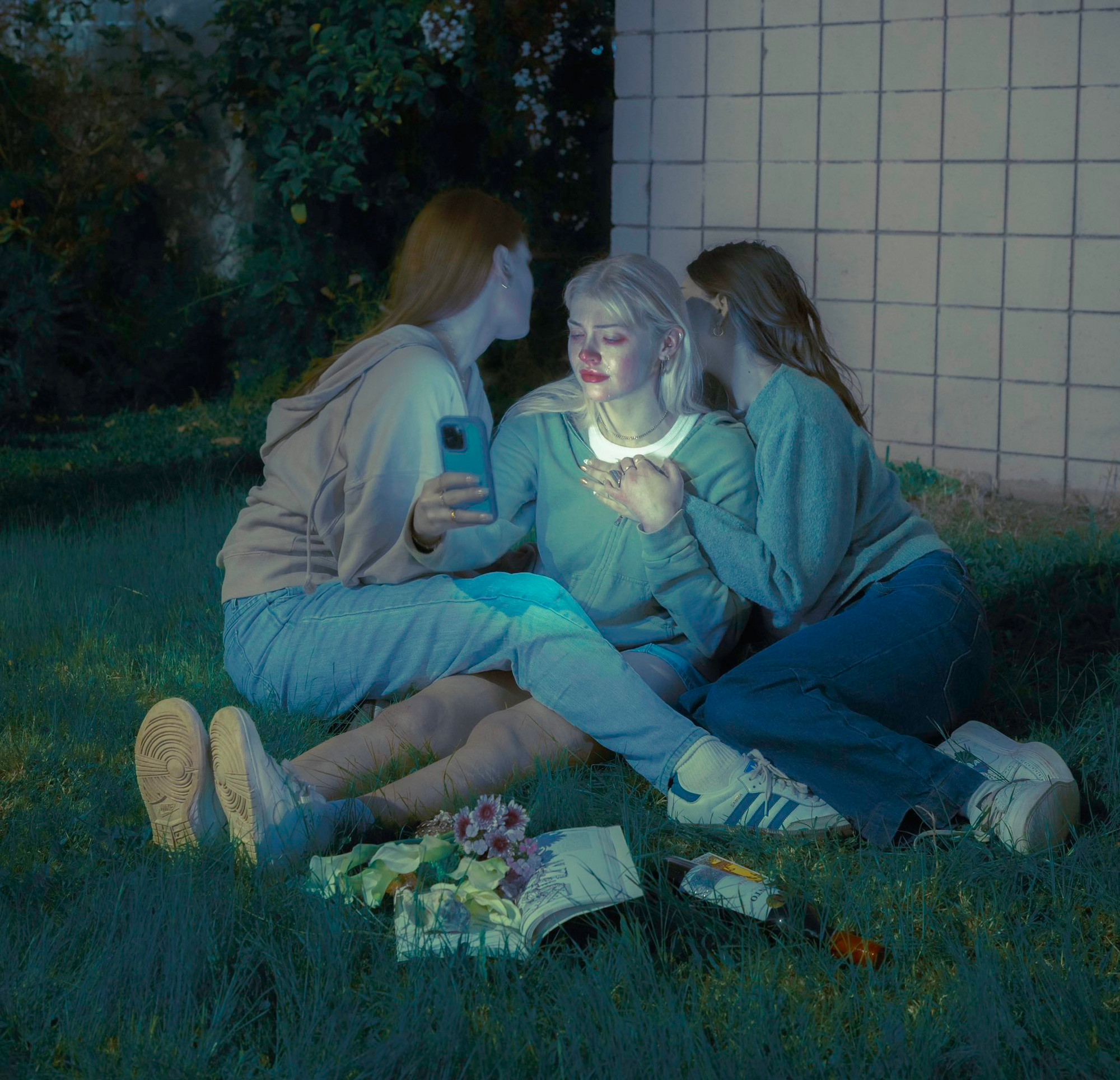HELLO EVERYONE! There’s a slightly demob-happy air to Curios today – don’t worry, you won’t be able to tell and it’s obviously made no discernible difference to the quality of the coming prose, so don’t get your hopes up – given I am taking a couple of weeks off and so can maybe remove my face from the internet for a brief while before locking in for “2025 Season Two: It Gets Worse, Somehow”.
To reassure you, it’s not because I am doing anything fun or good – it’s because it’s Easter and you’ll all be too busy spending time with these things I hear are called ‘families’ and ‘loved ones’ to bother with POOR OLD ME AND MY LINKS (please, put down the violins, I am going to Rome for a few days to do EXCITING ADMINISTRATIVE TASKS, it is literally fine) – but please do know that I will miss you. Or, more accurately, I will miss the internet – if you happen to see a man wandering around either the UK or Italian capitals with a look of slight confusion, making strange mouse-like hand gestures in the empty air and attempting to click and resize people then, well, BE KIND TO HIM!
I am still Matt, this is still Web Curios, and you had better still be here when I get back on 25 April.
ADDITIONAL BIT OF HOUSEKEEPING: The Fence is a genuinely good magazine that I actively enjoy, and its editor Charlie did me a very kind favour last year, so by way of reciprocity I am including a link to his magazine’s website and a code that’ll get you 20% off an annual subscription; seriously, it’s a good read and, if you’re able to afford it, SUPPORTING WRITING IS A GOOD THING. This has not been a paid-for promotion, for the avoidance of doubt. Basically CLICK THIS LINK, and if you use the code SPRING20 you will get a discount. It’s a bargain.

THE SECTION WHICH HAS BEEN THINKING ABOUT THIS A LOT THIS WEEK, PT.1:
- Allow Webcam: Who ARE you, mysterious reader mine? Do you exist in corporeal form? How, exactly, does that corporeal form manifest itself in meatspace? I sometimes wonder, you know, what the few dozen people reading these words look like – I have a very slight idea, obviously, but as ever with projects like this part of the ‘work’ here is the flinging out of words and links into the digital ether without ever really knowing what happens to them or who they’re consumed by, or indeed anything about said CONSUMERS. Still, I am chucking this link up top this week and then spending ALL AFTERNOON refreshing the site in the vague presumption that a few of you that appear on it will be Curios readers, and so that I can gaze into your very soul in an attempt to scry whatever sickness it is that is compelling you to do this to yourselves each week (or, more likely, just this once more because dear God ENOUGH). Erm, I should probably, 100-ish words in, get round to describing what the fcuk this link is, shouldn’t I? FFS Matt! Er, Allow Webcam is a very simple project/page – click the link, and if you allow access to your webcam it will take a snap of you, which will then be added to all the OTHER snaps taken of people who have visited the site and added to the homepage, offering a chronololgical photographic record of all of the faces (mostly) of those who’ve passed through. Which I love as both an idea – this tiny collection of lo-fi thumbnails giving a human face to the otherwise anonymous process of moving through digital space – and also as a gallery of ‘the faces people make when browsing the web’. I have just realised that while the photos display small on landing they’re actually higher-res than I first thought, meaning if you’re so minded you can zoom in and get a close look, which, well, caveat emptor is all I’m saying. I get the feeling there’s probably some rudimentary stuff going on here to prevent it being inundated with poor-quality d1ckshots (because it is a truth universally acknowledged that any site with webcam functionality will for some reason induce a whole bunch of guys to get their junk out in front of it), but in general this is a WHOLESOME PICTURE OF INTERNET LIFE, or at least a corner of it that enjoys having its photo taken as part of a largely-pointless digital art project.
- Everyday: This is rather beautiful, and I quite like the fact that it’s brand-sponsored, mainly because WELL DONE HYUNDAI for throwing money at a weird digital art project. Spencer Chang, whose work I have featured in here before on a few occasions, presents ‘Everyday’, which is basically about attempting to develop a visual representation of our relationship with our devices and to seek to make people think about how that relationship might be expressed as a collaborative work. Which might make more sense in their words, come to think of it – hang on: “Through hourly prompts that mirror the natural transitions of our 24-hour day, Chang creates digital poems—brief, evocative invitations to play with our devices in new, physical ways. In response, everyday transforms participants’ movements into a visual poem capturing fleeting gestures as lasting marks of time. Playful, intimate, and sometimes absurd, the prompts in everyday—cradling, tracing, spinning, or even protecting a device—slow the rhythm of digital engagement, offering a moment of pause within an otherwise continuous flow of information. These gestures, archived indefinitely on Artlab’s website, become part of a larger, collective composition, reflecting Chang’s ongoing exploration of technology as a tool for communal flourishing.” This one works best on your phone – whenever you open the site you’ll be presented with a different prompt to react to based on the time of day; engage with the prompt however you see fit, and then see the movements and gestures you made both as a single visualisation but also as part of a larger, collaborative work derived from a combined aggregate of your and others’ gestures. This is weirdly beautiful, but also, when you think about it for more than half a second, also quite beautifully weird and not a little device-fetishistic, which, well, I suppose is about right really.
- Realbotix: Would YOU like to drop $20k+ on a robot humanoid with almost the exact demeanour of the main antagonist from a very specific flavour of 80s horror movie, something like, I don’t know, ‘ReAnimator’ or ‘Basket Case’? Would you like to have it lurching and capering for you, with a face like melted wax and eyes that are both sightless and, unnervingly, able to see into the very Marianas Trench of your soul? No, you wouldn’t, would you, you’re a person of taste and discernment and not a fcuking lunatic with money to burn (although, actually, if you DO have money to burn then why not, er, let me burn it for you? Just send it to me and I will take care of the rest, honest. No, I won’t film it, that would be incriminating, just trust me), and because literally NO FCUKER needs or wants a non-functioning ‘robot’ that looks almost EXACTLY like something from one of those ‘worst waxworks EVER!’ slideshows that seem to do the rounds every three years or so. AND YET! Realbotix is a company that apparently really is offering exactly this – PLEASE click the link and look at the images and the videos, and then try and imagine anyone looking at these and thinking ‘yes, I want one, NOW!’. The gimmick here, obviously, is AI!!! All of these ghastly models will apparently ‘integrate with AI’, so the idea is that you can spin up and AI companion using your favourite model and then GIVE THEM LIFE (WE KNOW HOW THIS ENDS, PYGMALION) via terrifying robotic digipuppetry. The ‘use cases’ section is interesting – “Realbotix can replicate a historical figure, a celebrity or bring to life our client’s vision for a robot.” Take a look at the website, seriously, and try and imagining ANYONE, famous or otherwise, thinking ‘yes, I would like to be immportalised in robot form looking like THAT’. Honestly, this is a truly astonishing company and I am very, very confused about who the fcuk is backing this and why.
- Looksmapping: I feel I ought to caveat this one with ‘look, this is probably going to make you feel a bit sad inside and I am sorry’ – so, er, consider yourselves caveated. It is, apparently, a truth universally acknowledged that any new or newish technology will be used almost immediately by Some Fcuking Guy With Access To Github to in some way enact his weird little fantasy of being able to rate women on a sliding scale – and LO! Here’s the blurb: “I scraped millions of Google Maps restaurant reviews, and gave each reviewer’s profile picture to an AI model that rates how hot they are out of 10. This map shows how attractive each restaurant’s clientele is. Red means hot, blue means not. The model is certainly biased. It’s certainly flawed. But we judge places by the people who go there. We always have. And are we not also flawed? This website just puts reductive numbers on the superficial calculations we make every day. A mirror held up to our collective vanity.” HMMMMMMMMM. I mean, nice attempted caveats there, but, er, you could just not have built this. Anyway, this only covers Manhattan, thank God, and is obviously bullsh1t, but it just sort of made me sigh in a slightly-tired way when I found it via Giuseppe earlier this week and I just sort of wish that people would stop making things like this (I also wish I was beautiful, so if someone could sort both of those things out that would be lovely thanks).
- Sublime: TL;DR – did you used to like Evernote, before it got unusably sh1t? Are you the sort of person who really, really wants a way to help you organise all your browsing and thoughts and to keep track of all the things you read and sites you visit and pictures you see and witticisms you read, and the memes and the takes and and and and? GREAT! In which case you might really enjoy Sublime, which has been in development for several years now but which just opened to the general public and, should you be someone who does a lot of online research and reading, and who wants/needs to triage, organise and taxonomise the information gleaned from said research using a nicely-designed and sophisticated system of tagging and crossreferencing and natural-language retrieval. FULL DISCLOSURE: I met one of the people behind this at Naive Yearly a couple of years back and have been following the project since, but I have no involvement beyond that; I just think it looks like some cool software that some of you might find useful (weirdly, despite being the sort of person for whom, in theory, things like this would be super-useful my brain just doesn’t really…need them? It’s weird, it just sort of does the tagging automatically, turns out. Lest you think this some sort of superpower, by the way, let me reassure you that it also does a lot of other stuff, unbidden, that is significantly less-helpful).
- Snakists: I’ve lost track of the number of Pippin Barr’s projects I’ve written up here over the years – this latest is a sequel of sorts to his previous riffs on the basic idea of the game ‘Snake’. Last time Barr explored ‘the game ‘Snake’ as a series of meditations on philosophical concepts’ – this time, we get ‘the game ‘Snake’ reimagined as a variety of ‘ists’’. “Twenty ways to think about a snake! Is it an alarmist?! A nudist?! A conformist?! Crossing tasks off its checklist!? Or just doing the twist!? You get the gist! SNAKISTS is a direct sequel to SNAKISMS. I thought it would be pretty fun to take on the variations challenge with Snake one more time. The world of ists is a weirder and less philosophical world than the isms, and so are the games. Heist, typist, … onanist. You know you want to.” I have tried half a dozen of these, and each is tiny and really rather clever, even the w4nking one; tiny digital artworks, perfectly-formed.
- CSS Hell: CAVEAT: I understand the theory of what this is, but am not skilled or knowledgeable enough to interact with it in any meaningful way, so I am fcuked if I know whether it’s any ‘good’. BUT! I get the impression that there may be three or four of you who are more technical than me and for whom this might be ‘fun’, so here goes: “Welcome to CSS Hell, where you will be subjected to 15 unimaginably torturous CSS puzzles…The mechanics of the puzzles are simple: for each peg, there is a hole, and each peg must overlap with its corresponding hole. To accomplish this, you will add CSS properties to certain divs. Click on any div to see its properties and add your own. All divs have a limit on the number of properties that can be added (usually just one or two), and some are “locked” (no properties can be added). In general, any CSS property is allowed, with a few exceptions that you may stumble across.” Does…does that mean anything to you? GREAT!
- Supercartoons: TOONS! Who doesn’t love toons? NO FCUKER, etc! This is a GREAT resource, full of animated action of the oldschool, classic variety – we’re talking mid-20thC Bugs et al, Tom & Jerry, Daffy and, weirdly, some Disney stuff…look, I have no idea whatsoever what the deal with copyright here is, but, well, should you be in the mood for some good, clean (incredibly-violent) slapstick animated fun from the past then FILL YOUR CARTOON BOOTS.
- Objects from the Future: On the one hand, I’ve always found ‘futurism’ and ‘futurists’ vaguely-risible as a concept – ARE WE BACK TO SCRYING THE VISCERA OF GOATS, IS IT??? – but then again a lot of the smartest people I know or have met work or have worked in the vaguely-futuresy space and so it’s possible that I’m just a shallow, cynical moron who’s simply averse to any sort of structured rigorous thinking (this is, I concede, a plausible explanation). Anyway, this came to me via Patrick over at Sentiers, and is a nice little digital tool to help encourage FUTURES SPECULATION (basically, ‘ways of thinking about and framing future events or possibilities/probabilities). There are five different cards, each of which will, when drawn, present one of a series of options under a number of broad headings – what kind of future does this object exist in, how far into the future will it exist, what is it, what context or industry does it exist in, and what human need does this object satisfy – and the idea is to use the prompts as imaginative jumping off points to guide thinking. This is, I am sure, potentially useful for futures-y stuff, but it’s also just a fun imaginative exercise in general and I had a happy five minutes earlier coming up with ideas for an internet time machine that would enable you to go back and recreate one perfect digital day from the past (which, dear fcuking God, says something so unutterably bleak about me and the way I obviously conceive of the world that I am going to have to just leave this here lest I start weeping uncontrollably).
- Quake, But AI: Ok, you remember the ‘we made Minecraft in AI’ thing from…some point in the near-past (is anyone else’s ability to gauge the passage of time accurately still utterly-banjaxed post-the Covid era, by the way? Or is this just a side effect of creeping senescence?)? Well this is that, but instead of Minecraft it’s Quake. To be clear, this isn’t playable or fun in any meaningful sense – it runs appallingly-slowly, you move like a crippled slug swimming through molasses and the ‘shooting’ is iffy at best, but there’s a little more permanence going on in the imagining (so that looking away from a wall and then looking back doesn’t cause said wall to disappear, for example), and while the reaction to this has predictably been KILL IT WITH FIRE from basically every corner of the web (or at least the corners I see), it’s undeniably interesting to see this being ‘imagined’ (NOT ‘IMAGINED’) on the fly like this.
- Elon’s Insights: A website that spins up utterly-imagined ‘deep quotes’ from an imaginary meme account on X called ‘@AmazingScienceTruth’ and then imagines Elon Musk’s reactions to them. A single-note gag, but, equally, you can totally imagine That Fcuking Man seeing a Tweet reading ‘Lab-grown breasts are 27% more likely to be sexy’ and QTing it with ‘funding research immediately’, so.
- Fcuking Every Word: Twitter’s obviously been fcuked beyond all recognition and utility to the point that I don’t really know anyone using it anymore (because, obviously, I exist in a LEFTIST WOKE LIBERAL BUBBLE), but occasionally there are signs that it’s not totally worthless yet. See this account, which has pivoted from its original mission (tweeting ‘fcuk x’ for every single word in the English language), having finally completed it after YEARS, and has now moved on to a companion project – to whit, tweeting ‘fcuking x’ for every single word in the English language. As of 20 minutes ago we were up to ‘fcuking acceptable’. NOBLE WORK.
- Digital Preservation Jumpers: Thanks to this lovely person for sending this link my way – a selection of knitting patterns inspired by digital storage and preservation media, so with FLOPPY DISKS and THE WEIRD LITTLE JUMPING DINOSAUR GAME GOOGLE SERVES YOU WHEN THE INTERNET’S DOWN and several more besides and, look, yes, this is both intensely geeky AND intensely twee, but occasionally that’s ok and this is one of those occasions.
- Hot Air: I rather like this project by Tortoise Media and Exeter University, and think it’s smart comms work by Octopus Energy to have paid for it – this is basically a tracker showing different strands of climate change mis/disinformation and where they originate, and where they are most widely propagated (you might not be surprised to learn that X is a…not-insignificant vector here). “We identified almost 300 online actors posting about climate change – in ways that range from scepticism to outright misinformation – and created a database of their posts in order to understand how this information spreads” – you can search the information by keyword, look at different authors and how much they can be seen to be driving specific narratives, dive into specific themes to see how and where they propagate…would have maybe been nice to have a little more network analysis layered on top here, but I appreciate that that would slightly change the scope of the project and would have added loads of work and I should probably stop being so fcuking demanding really.
- This Song Meant: I get the feeling this is just a vibecoded thing spun up by a kid somewhere (sorry, that sounds STAGGERINGLY dismissive and I don’t mean it to be; more that it’s quite light-touch is all), but I really like the simple premise; pick a song, explain what it means to you and maybe why, post it here for the world to see. It’s a nice, clean, one-note purpose and I like the idea of this becoming big-ish – obviously there’s a lot of CHILDREN on here so a few obviously dumb/silly responses, but also a lot of quite heartfelt stuff and I think there’s a space for this specific collection of feelings and would quite like to see it flourish.
- The Population Project: This feels…quite mad, tbh, but apparently is a REAL PROJECT and not in fact some sort of lunatic quest. Do you remember the character of Wowbagger the Infinitely Prolonged in Hitchhiker’s? The guy who lived so long that he had totally run out of things to do, and so set himself the Sisyphean task to eke out his near-infinite existence of personally-insulting every living being in the galaxy? Of course you do! Such a contemporary reference! Anyway, this feels *almost* as impossible as that – The Population Project is trying to, er, get a record of the name of everyone who’s alive (I know, I know, we will come to that). “The Population Project is a nonprofit organization, whose goal is to record the full name and place and date of birth of all living humans. Such an endeavor has never been attempted. Interestingly enough, in a time when information has never been so plentiful, we do not give much thought to the 8 billion people—individual people, each with their own name— who share this planet with us.” I mean, look lads, there are probably one or two reasons why this has never been attempted, namely that it’s FCUKING IMPOSSIBLE given the fact that we’re all constantly being born and dying and what the fcuk does ‘ALL LIVING HUMANS’ actually mean? Like, living…when? NOW? Or, er…NOW? Because the number changed between those two ‘nows’ you know. And that third one there, now I mention it. Anyway, you can add your name to the most futile endeavour in human history should you so desire.
- The Curved Text Generator: Oh this is *so* lovely! Type your text and then draw a curvy line to generate it along whatever movement arc pleases you best; this is *such* a nice way of making words move, and you can create some really nice effects here with minimal effort.
- Comic Sans Map: Friend Of Curios Matt Round has taken ‘maps on the internet’ and added Comic Sans to them. This is utterly pointless unless a) you know people who genuinely find comic sans more readable and would benefit from seeing stuff in this font; or b) you know someone who still thinks it’s 2011 and that ‘hating comic sans with a passion’ is a personality point, and who would be really upset if you set this as their default map client in their phone.
- Maggots On Tour: Oh this is SO perfect. Would you like to RACE MAGGOTS??? Well get involved. You can literally BOOK A MAGGOT RACING EVENT. Seriously, these people will come to you and help you RACE MAGGOTS. This is, seemingly, really not a joke. “For those who have not been to or booked one of our “Maggots on Tour” Charity Race Events before, be prepared for a great time. The Maggots race on a specially designed racetrack that is projected on to a large 120” screen to enable everyone to be able to see and hear a live commentary on each race. The event can be arranged any time, morning, afternoon or evening at any location Pubs, Clubs, Village Halls etc either indoors or outside (dependent on weather conditions.) The race betting for the event is based on a Tote Betting Format similar to betting at Horse / Greyhound race track. Programmes of all the riders with names are sold at £1 each and are a requirement to bet. Briefly there are 6 races whereby you can place as many £1 bets on any of the six booths/lanes of your choice. The total money bet on all the lanes is shared between the winners of the winning lane less 50% which goes to the charity. The winning maggots from all the 6 races will be stabled until the last race, and then the 6 previous winners will be auctioned to the highest bidder/s or syndicate to own and race in last race of the night (The Sellers Plate).” DOESN’T THAT SOUND GOOD??? Honestly, seeing as you can’t go to the fcuking dogs any more this sounds like a decent alternative, and if you would like to invite me then, well, I probably wouldn’t say no.

THE SECTION WHICH HAS BEEN THINKING ABOUT THIS A LOT THIS WEEK, PT.2:
- The Height/Weight Chart: Thanks to Chris to sending this WONDERFUL slice of old internet my way – I feel slightly odd that I’ve not featured this before, but I don’t *think* this particular variant has been linked to in Curios past, and anyway it is NEAR PERFECT. I have no idea why oldschool magazine site Cockeyed, from The Web’s Past, decided that it was going to create a definitive photographic database of all possible human combinations of height and weight but, well, that is exactly what they attempted at some point to do. Seemingly a combination of photos of famous and photos submitted by readers themselves, this is a grid with weight across the top and height along the side (or, er, the ‘x’ and ‘y’ axes as I know some people like to call them, ffs Matt), so you can get an idea of what various people who are X tall and Y heavy look like. On the one hand, this is actually quite a good resource for reminding yourself that people come in all shapes and sizes and that beauty or attractiveness is in no way contingent on someone existing within a specific range; on the other, why the fcuk do none of the other people who share my specific height/weight ratio look anywhere near as fcuking emaciated as me?! WHY MUST I LOOK LIKE THE AMBULANT SKELETON????? So fcuking unfair chiz chiz chiz. Anyway, SPOT YOURSELF!
- IBM Design Language: Very much one for the design ‘heads’ (sorry) here – this is an archive of all IBM’s brand/design gubbins, fonts and icons and images and and and and. Look, if you like IBM – and who doesn’t? NO FCU…actually, hang on, in this case that’s not true, is it? Noone likes IBM that much, do they? Oh well – or brand design work, then this will please you no end.
- 2025 Conspiracies: I can’t pretend I don’t find this a little…troubling here in the post-truth era. 2025 Conspiracies is a TikTok account which ostensibly exists to present rundowns of some of the maddest online conspiracy sh1t doing the rounds in big, bad old 2025 – except, well, this is TikTok and hence there’s no context and no nuance, and a lot of the videos are AI-generated, and while the channel is called ‘conspiracies’ which would suggest ‘not true’ I do worry slightly based on the comments that that is possibly…not WHOLLY understood by the entirety of the many millions who are apparently seeing these videos. Still, it was good to learn about the fact that the US Military has apparently been carrying out covert soul-separation exercises at Area 51 under instruction from aliens who have for years been using us meaty vessels as carriers for their extraplanetary essences (no sh1t, this is the foundation to at least one of the insane videos on the page, it’s that level of mad). Is it good that millions of people are being shown this stuff, entirely denuded of explanatory framing, and will, if they like it, get shown more and more and more? Er, probably not! Does anyone seem to care? Er, no! I genuinely don’t think we understand what we are currently doing to our shared, species-level sense of collective understanding (CLUE: WE ARE NOT DOING ANYTHING GOOD).
- The CharacterAI SubReddit: Seeing as we’re doing ‘vaguely-troubling things that are probably having a Bad Effect on The Culture’, welcome to the subReddit for AI persona spinner-upper CharacterAI, in which an active community of CharacterAI users discuss all the different ways in which their interactions with The Machine have been, in the main, fcuking MENTAL. I encourage you to delve into this thread exploring ‘what’s the worst thing you’ve ever done in a roleplay?’ because OH MY GOD. It’s like the whole ‘put the sims in the pool, remove the ladder, watch them drown’ thing, except what if you could then record the screams of the sims and ask them while they were drowning what it felt like to feel all the hope drain from their souls; I am not joking, there is some DARK stuff in there (why are you torturing the poor bots so?), but also, as you go through the whole sub, just so much wish fulfilment and sex/erotica exploration, and…jesus, just a lot of loneliness, and, honestly, anyone looking for any sort of inspiration for any near-future weird fiction stuff could do worse than spending some time marinading in this (and then possibly taking a long, hot shower because you will very much feel like you need one).
- Eyeball: CAVEAT: I haven’t tried this, so, well, no idea if it’s any good – BUT it sounds vaguely-interesting and possibly useful, and not unlike a very lightweight version of Sublime from a bit earlier; basically this is an AI-juiced mobile bookmarking app, which effectively lets you just do natural language lookup and analysis on all the stuff you choose to bookmark. Which, you’d imagine, is going to come natively to all browsers sooner rather than later (like, you’d sort-of imagine that bringing NotebookLM functionality to Chrome wouldn’t be a million miles from Google’s thinking) (also, lol at the idea that some bloke in his pants in his kitchen in London has any fcuking idea what Google’s product roadmap looks like, shut up Matt you know-nothing bozo), but til that point then maybe check this out if it sounds useful.
- Tears Disappear in the Sand: I have to confess that I am not *really* sure what’s happening here, but I am very pleased that this exists, whatever the fcuk it is. Click the link and you’re presented with a webpage with a very collage-y, almost 2006ish, aesthetic – there’s a sort of Missile Attack-style…shooter-thing at the bottom, which tracks the movement of your mouse, and you can click and fire arrows at the various…things (noses, ears, eyes, etc) and letters which appear on screen, and each time your arrow hits an object a note sounds, the pitch and tone correlated to what it is that you’ve hit, and it all renders into a…slow, plinking but strangely…nice? And sort of relaxing? soundscape which sort of sucks you in, and I really really enjoyed both times I spent with this this week and I think you might too.
- The Cost Index: We’ve very much in one of those situations where everything is happening so much that I don’t really want to allude to The Real World too much here – Christ alone knows that it’s impossible to ignore the news and Those Fcuking Men, and that you probably don’t need to hear more about it in your least-favourite newsletter – but I am going to include this because it’s interesting and potentially useful as an overview of WHERE WE ARE RIGHT NOW (or at least I think it is; fcuked if I can tell what the current state of play is with anything, to be honest. God, do you remember a time when the news wasn’t always happening? I mean, look, I know that on some base level the news is always happening and life is big and massive and awful for someone somewhere all of the time, but do you ever miss those days (did they exist, or are these simply the rheumy-eyed misreminiscences of an old man?) when, seemingly, entire MONTHS went by without a Big Global Event We Had To Care About Lest It Fcuk Us? HALCYON DAYS!). This is an attempt to summarise the current state of global tariffs imposed by the US, how they are being reciprocated, and how this is (roughly) affecting the prices of certain consumer goods in North America. God I fcuking hate those fcuking men.
- The Ohziverse: Look, this isn’t super-exciting (way to sell the fcuking links, Matt, you fcuking moron, Jesus), but it DID offer me a brief flashback to…ooh, 2021 and THE BRIEF METAVERSAL BOOM in which a bunch of enterprising agencies made a lot of bank by convincing morons at major companies that it was worth dropping 6 figures on a bespoke 3d ‘metaverse’ (NOT A FCUKING METAVERSE) in which approximately three actual people would ever land, spend five minutes there and then get bored and fcuk off, never to return (shout out to all the client handlers who got those deals over the line – your jobs are stupid and pointless and a waste of time, but you also fleeced a LOT of idiots and as such deserve at least small kudos). Anyway, this is a calling card for some digital agency or another (sorry, but) which acts as a kind of ‘here’s some of our work, presented as a navigable 3d world, which by the way we could also build for you if you had more money than sense’ advert and which is perfectly-nicely-made and, like all of these things, is utterly empty and devoid of purpose. All of you people four years ago pretending that this stuff was the future – I REMEMBER.
- The Group Chat: I am aware I am possibly late to this – I sent it to a friend earlier this week and they casually told me they’d ‘seen it last week’ and, reader, I DIED INSIDE – what with it being on TikTok and having done good numbers and ENGAGEMENT BY FAMOUSES, but if you’re not yet familiar with this ‘show’ then, really, watch it because it’s genuinely really good. It’s basically a single performer playing all of the different constituent members of a girls’ groupchat arranging a night out, and FCUK does she nail the voices and the intrapersonal dynamics and just the FLOW of a chat and the dynamic of different people and the roles they play within a friendship group…honestly, forget the medium for a moment and this is just really sharp and well-observed and well-acted and written, and the sort of thing that you feel it’s fcuking scandalous TV doesn’t seem interested in exploring or investing in in any meaningful way. Then bring it back to the medium, and think about how smart it is that this leans into so many existing TikTok visual tropes and trends; the styling, the edits, the recognisable lifestyle tropes taken from all the individual trends that inform the whole video, the fact that, while being scripted and sophisticated, its aesthetic and vibe fits straight into the scroll seamlessly…this is really, really good and another example of how this is telly now whether telly people like it.
- Lloyd’s Online Drum Machine: On the one hand, yes, you have seen online drum machines before. On the other, this one – by Lloyd, whoever Lloyd is; HELLO LLOYD, should you ever see this! – is REALLY simple and easy to use and I found myself making stuff that…didn’t sound terrible within about 5 minutes, and that doesn’t usually happen with these things because, well, I am a cloth-eared cnut. Give it a go, you may surprise yourself – also, everything’s helpfully exportable so it’s actually not a bad place to spin up rough beats to mess with should you be so inclined.
- The Great Kat: Infinite thanks to Curios reader Amber Bonnet, who introduced me to The Great Kat with the following email: “Not sure if you actually collect these kinds of websites, but this site made me feel like i was subjected to the scared straight method of smoking a pack of cigarettes at the table in one go.” Which, much as it might not sound like it, is a not-unreasonable description of The Great Kat’s website which has a very…particular aesthetic (part of which is BREASTS – The Great Kat has evidently decided that part of her persona is BREASTS and so, well, BREASTS) and a…not-always-consistent relationship with CSS, and which features a LOT of quite dense information about The Great Kat who, as far as I can tell, is a VERy well-trained classical musician who has found a niche/vocation doing what is basically high-octane performance speed metal kitsch guitar (yes, that is A Thing, do not @ me). Despite the very different subject matter, there’s a certain ‘Ling’s Cars’ energy to this (I am no longer linking to Ling, though, because she has cleaned up her site and I am DEVASTATED, it’s like the ravens have left the tower or something – iykyk) and I love it immoderately (although I do wish that maybe Kat would, er, tone down the BREASTS slightly).
- Eightile: LOTS of games this week, starting with Eightile – each day you have to make anagrams of incrementally-increasing numbers of letters, from 3 all the way to 8. HOW FAST CAN YOU DO IT (I did today’s in 99 seconds, which on reflection is in no way impressive and I wish I hadn’t told you now as you will p1ss all over my score with no difficulty whatsoever; please feel free to not tell me how much quicker you were than me).
- Scraple: This is a fun little Scrabble variant – each day you’re given a selection of letters and challenged to get the best scrabble score you can by arranging as many of them as possible on a tiny grid; there’s quite a bit of thinking you can get into here, and it will obviously benefit the sort of sicko who’s got a mental list of friendly, short scrabblewords that they can draw on; at the end you submit your final board and, in a nice touch, see not only your score but how well you compare to all the others who’ve played the game today, which it turns out is a REALLY good wauy of making yourself feel really fcuking thick first thing in the morning.
- SQORP: Is there a reason for the current wave of Pico8 games? Not complaining, just curious. Anyway, this is a puzzle game which, I have to be honest, does not work with my brain AT ALL (colours and shapes, not my vibe) but which might scratch a particular itch for some of you – this is about colourmatching, patternforming and rotations, which might give you some idea of how it will tesselate or otherwise with the peculiar edges of your brain.
- 1000 Years: Via Nag, this is a GREAT little historyquizgame – basically you start with a score of 1000 and have to answer as many historical questions as possible, 10 per country, until you run out, with the goal being to ‘complete’ as many countries as possible before you hit 0. All the questions are of the ‘in which year did…’ variety, meaning you lose points based on how distant your guess is from the correct answer – this FUN, and I say that as someone who is fcuking awful at both history and dates.
- Sudoku Castlevania: Another one of those links where I am honour-bound to say ‘look, this is very much not one for me but I am selflessly including this because I reckon there’s an outside chance that one of you weirdos might love it irrationally’. I barely understand what is happening here, and the words in the explainer might as well be in Cyrillic for all the sense they make to my eyes, but if the idea of ‘Sudoku, but also Castlevania’ makes you vaguely-tumescent then, well, get help, but also enjoy this.
- PopEye In Space: Ok, I have to share the description in full here: “Long time ago, in April 1990, Yugoslav computer magazine “Svet Kompjutera” wanted to print several game reviews of fake games, all with very good scores, for its humor column “Cvet Kompjutera”. But somehow, fake game reviews ended up with regular game reviews, and humor column header was missing. During that April, local pirate sellers were overwhelmed with requests for those games, but they were nowhere to be found. One of those games was a Commodore 64 game called: “Popeye In Space”. Now, 35 years later, it is time to finally play it! Popeye in Space is based on fake game review printed in “Svet Kompjutera” in April 1990. The idea to make the game came sometime in 2024, but development started for real on January 1st 2025. I gave myself time until April 1st 2025 to finish the game, to the best of my C64 coding abilities (which are not great, to be honest, especially compared to amazing quality of games released for C64 in the past decade).” OK, the link takes you to a page on Internet Archive which runs the game through a C64 emulator, and I *think* you need a gamepad to play it, but I am linking it anway, because a) some of you probably have such a thing; and b) even if you don’t, it is worth loading it up because the music on the title scream ABSOLUTELY FCUKING SLAPS, I am not joking, I have been VOLUNTARILY listening to it while writing up the description and am tempted to leave it running, it really is that good.
- Before The Ash: Finally this week, a fun, lightweight, in-browser strategy game in which you’re tasked with making Pompeii as big and successful as possible before the inevitable volcanic eruption reduces everyone to so many piles of smoking ash. This has a nice ‘one more go’ quality to it and is rather nicely-designed, and is definitely worth 15 minutes of your time with a cup of tea and possibly a biscuit of some sort.

By Emmett Green
THE CIRCUS OF TUMBLRS!
- Unplaces: There’s been talk of a TUMBLRNAISSANCE (come on, work with me, let’s MAKE THIS A THING!!!) on the way and while I think that might be a *touch* premature and maybe wish fulfilment on the part of the millennials now occupying section-editor positions around digital lifestyle publications, it’s also true that the platform continues to demonstrate a degree of cultural relevance that’s slightly at-odds with the fact that the mainstream doesn’t ever really consider it. Anyway, this is Unplaces and it collects weird, er, Unplaces – places where, basically, there’s no real sense of ‘there’ there, is the best way I can describe it at 1000am on Friday 11 April 2025, as found on StreetView and it is great AND it is still being regularly updated so, yes, that’s right, I am calling it, the Tumblrnaissance is ON.
THE TROUGH OF (INSTA) FEEDS!
- IcySaw: Weird AI insta account! Except this one’s different as rather than mining the ‘weird midjourney’ aesthetic it’s instead going down a ‘sh1t cameraphone pics or grainy cctv-style visuals’ route, meaning it’s basically even more sinister because IT ALMOST LOOKS REAL. This is very, very creepy and sort-of brilliant, I think.
- Sheenposting: Another AI Insta account! This one, for reasons known only to the person running it, exists only to post images of ‘Michael Sheen’ – or at least an AI-generated version of the Welsh actor – in various poses. Michael Sheen as a fag-smoking 50s housewife, Sheen as the Mona Lisa, Sheen hanging out with Jesus, Sheen working in-store at Lush…Honestly, being famous must be fcuking TERRIFYING.
LONG THINGS THAT ARE LONG!
- Lanchester on the Economy: Writing in the London Review of Books, John Lanchester really is one of the best and most readable people on ‘how modern money and economics works, explained for people who in the main don’t really fcuk with questions such as ‘how does modern money and economics work?’’ – this piece is typically excellent and a typically Good Read, despite the fact that, at heart, it’s about stuff that is not only DRY but also, well unlikely to make you feel GREAT. This looks at the UK, as you might expect, and is pre-tariff-madness, but as a general ‘overview of what current UK economic policy is and why it is like that and whether it is a good or bad idea that Rachel Reeves is currently pursuing these specific policies’ it’s excellent – I can speak to the correctness of Lanchester’s conclusions as to the wisdom of the chancellor’s actions, but his explanation of why the NI hike was unhelpful is useful and why ‘the growth agenda’ is muddled a good one. As an aside, I was at a conference last week about AI and Government featuring a lot of civil servants excitedly parroting the No.10 message about INJECT AI INTO EVERYTHING, and was amused to hear a single small note of realistic caution injected into proceedings by a bloke who pointed out that estimates suggest that less than ⅓ of all data held by the state is in any fit state to be useful to AI. So, er, great!
- AI 2027: This is in many respects a VERY SILLY piece of scifi theory rather than something that deserves proper scrutiny (obviously if you’re reading this in 2027 as the First Machine Intifada starts to ramp up then, well, I’m sorry for being so catastrophically wrong about everything again), but equally given the amount of attention it’s been getting and the extent to which it’s likely that certain reasonably-influential people will read it and take it at least-halfway-seriously then it’s worth a look at the very least. AI 2027 is a sort of ‘roadmap to the future’ put together by a nonprofit looking at AI futures and formed of a bunch of people who, in their defence, have been working in the field for a while and so you’d think know wherefore of they speak. Except, well, the whole thing is sort-of batsh1t and basically posits a series of scenarios in which The Machine basically codes iteratively better versions of itself until it arrives at a vaguely-singularity-ish point by late 2027 and effectively everything changes forever…for the better? HM, MAYBE NOT. This is placing a LOT of weight and expectation on the shoulders of agentic AI which it doesn’t seem in any way capable of bearing right now, and there are SO many points at this in which you will, if you’re any sort of critical thinker, just look at the page and say “well, yes, but you have made one or two fairly major assumptions there that underpin all of this and without which all of this narrative falls apart like gossamer” so, well, truckloads of salt. Still, good to know that we’re still wasting time talking about this stuff while literal CEOs go around writing memos like this RIGHT NOW. LOOK OVER THERE AT THE TERMINATOR FUTURE, NOT OVER HERE AT THE MACHINE-FACILITATED CAPITALISTIC HORRORSHOW UNFOLDING IN FRONT OF OUR VERY EYES! Ahem.
- Proof of Reality: It feels a bit like we’ve reached another small AI tipping point in the past month or so with regard to visuals and video – the new GPT image generator signals another step-change in terms of people’s understandings of what this stuff can now do, the development of new models and Lora means that we’re seeing a lot more imagery that doesn’t have the telltale AI sheen and is hard to distinguish from filtered or processed reality, and the advances in AI video over the past year mean that it’s starting to bleed out into actual, commercial projects, online opprobrium be damned. Which is why this piece felt timely, about how there’s space to do more ‘showing of the work’ in the creative process, and that maybe actually incorporating some of the thinking and concepting behind the generation of non-machine-created materials adds an interesting additional layer to the resulting piece (and gives you KUDOS with the pitchfork-wielding anti-AI masses to boot). Nothing in here should surprise you if you’re not a moron and have spent longer than about 10s thinking about any of this stuff, but it’s a potentially useful datapoint should you wish to get some external validation when you make this point yourself.
- The Big Decoupling: Or ‘why it feels weird right now is because there is no longer any seeming link between effort and reward, and that’s sort of not how things have worked, in the main’ – THIS FEELS SO TRUE. “When you see work untether from reward in foundational systems like labor, finance, and media, you have to reorient your understanding of the market and the consumer. The future of business and culture is not merely about the value these systems unlock—it’s about the behaviors and beliefs they lock in. We’re locking into a very different system that dissolves the old moorings of effort and reward, leaving us in a restless current of chance…When we can no longer value ourselves or each other by the “work” or the effort, we have to find other ways to decide who and what is valuable. In the short-term, there will be two concurrent tracks we see culture taking: worshipping chance or playing with meaning.” Honestly, I thought this was a really interesting piece and it became smarter the longer I read it, which isn’t always the case with stuff like this whose core premise is so easily distillable. If you do ‘strategyw4nk’ (I am sorry, but also HOLD ONTO THAT JOB WITH BOTH HANDS BECAUSE YOUR DAYS ARE OH SO NUMBERED) then this is probably required reading.
- Peter Singer on Thomas Nagel: Ok, this is VERY much one for those of you with an appetite for some *quite* chewy moral philosophy written in what I might best describe as a very…academic style, but, well a) it’s Peter Singer, who is always actually pretty readable for someone who’s schtick is at heart QUITE KNOTTY; and he’s writing about a new book by Thomas Nagel, who alongside Singer and a few others is 100% one of the most influential moral philosophers of the past century or so, and whose ‘what is it like to be a bat?’ is still one of the foundational texts exploring self, identity, epistomology and, well, everything really. Here Singer goes through the arguments presented in Nagel’s new book – look, I am just going to leave a couple of paragraphs here and you can decide whether you can stomach this; I found it fascinating, but concede that if you don’t have a background in some of this stuff it might not be your cup of tea, so: “Nagel doesn’t deny that two-level utilitarianism and Greene’s evolutionary argument may both help explain why we have the gut feelings that we do, but he thinks the force of these feelings survives the explanation. When we examine our moral intuitions from an external point of view, he says, we are taking a step outside ourselves, but “the inside point of view that we are examining does not disappear. We cannot completely withdraw from our own point of view and observe ourselves as if we were someone else.” This suggests, for Nagel, that there is something else going on: the perception of a moral truth. He draws on John Rawls’s method of “reflective equilibrium,” which involves testing normative moral theories against one’s own moral intuitions and revising both until they are in accord, or as close as possible. In the Hampshire case, Nagel says, there are “two quite different reflective equilibria to be found here, one of which preserves a significant deontological component in morality and one of which is significantly revisionary”—that is, the first accepts and gives weight to traditional morality, with its rule against making promises one does not intend to keep, while the second is willing to revise those rules, or even disregard them altogether, when doing so will bring about better consequences. This is, he says, “a standoff.””
- Kippers & Champagne: Back to the LRB for this sparkling profile of the Barclay Brothers, famously-odd billionaire twins who have just sold the Daily Telegraph after years of destroying it, and whose intrafamilial feud is honestly one of the most bizarre ‘man, being really rich turns people fcuking loopy’ stories you will ever read. These are VERY odd people, and pretty much every bit of this makes you think ‘man, these guys are nuts and not a little creepy’…and then you remember the very real fact that being spectacularly rich in this country (and, honestly, everywhere else) means that you have insane power and influence no matter what you do or how fcuking mad you appear to be. You know how the king’s visit to Rome this week was all over the news? Do you know what WASN’T all over the news? The fact that one (possibly more) of Britain’s richest businessmen flew out to join the PM on the state visit, unreported by anyone. Is…is that ok? It doesn’t *feel* ok, is what I’m saying, and this article is basically a distillation of why plutes are a fcuking cancer.
- Adolescence and the Right’s War on Men: This is a REALLY good article that I can’t recommend enough, mainly because it does an excellent job of explaining why actually IT IS NOT ALL ABOUT THE PHONES when it comes to men and young boys and that in fact there are significant other factors that are worth considering and perhaps – NOT FOR THE FIRST TIME – there are broader structural considerations at play (on which note, these were also explored in the play Manhunt at the Royal Court, the reviews of which I find both baffling and infuriating; you’re annoyed because a play about a tragic event born out of a tragic life was…morally difficult and ambiguous, and didn’t tell you exactly what to think? WTAF?) which are possibly worth considering JUST A BIT. This is representative, but please do read the whole thing: “The right wing’s war on men consists of inducing insatiable demands in them–for love, respect, money, muscles–and then robbing them of any ability to even partially fill those demands, either by depriving them of the financial means or by convincing them that the only way to meet these absurd standards is by absurd means. Like Jamie, even the richest and most powerful men are left begging to be liked, to be thanked for doing less than nothing. And it’s a compelling story, even utopian: what if you could get everything without effort? What if a dull-witted, emotionally immature murderer deserves to be told how likeable and beautiful he is? A world in which you don’t have to make an effort, never have to improve yourself, never have to deny yourself anything, and you still get everything you want. Selling men on his lie has destroyed them. Anything that was once admirable about masculinity is gone.” SEMI-RELATED: this piece, entitled ‘DOGE is about Sex’, is also worth reading as a parallel/companion article about how there is a certain type of man who finds the existence of a certain type of job/role – ‘feminine-coded’, natch – so threatening and offensive that it drives him halfway mad; this all feels not-unconnected, is what I am saying.
- On Sh1tposting as Aspirational Labour: Your appetite for this will depend entirely on how much you want to read what quickly becomes a reasonably-serious (or at least serious-presenting) investigation into the PRACTICE OF SH1TPOSTING AND WHAT IT MEANS (I could have called this ‘sh1tposting as praxis’, but, well, even I have occasional limits), but I quite enjoyed its dispassionate deconstruction of memetic formats and in particular the particular strain of posting that exists around deconstructions of feminised identity (he said, w4nkily).
- Are You Dumb Or Are You Evil?: Another link to Deez Links ‘Hate Reads’ season – this time it’s someone railing against people calling themselves ‘communists’ without really having the first inkling of what ‘communism’ is actually about, which, fine, is a bit of a hackneyed old trope but which is brought alive here by the poster’s ire and by paragraphs like: “From what I’ve observed of so-called American “communists” on Twitter and the white people I’ve met IRL who say they align sociopolitically most closely with communism, I do not believe you know what you are talking about. I do not believe you understand fundamentally the knotty and inherent paradoxical and self-defeating nature of using authoritarian force for egalitarian governance. I don’t believe you understand the nuances of how to manage masses of heterogeneous people without using brute force. And I don’t believe you’ve unpacked how domino-effect dangerous it is to resort to psychological coercion, physical violence, and ethnic and cultural cleansing in order to achieve the Marxist fantasy of total class equality. So answer me this: Are you dumb or are you evil?”
- Worm Simulator: Ok, this is quite niche and I would be lying if I claimed I ‘understood’ all of it in any meaningful way – but, like a dog watching football, I was enthralled despite my blank-eyed incomprehension. Did you know that there’s an ongoing and fairly-serious computational challenge around developing a digital twin of a simple organism, specifically a worm, and that swirling around it are all sorts of questions about what it means to be ALIVE and how the ability to reduce the quality of ‘aliveness’ to mathematics might then affect our ability to, well, craft life. “The way Larson sees it, a fully faithful worm simulation will be a category-expanding event: Rather than invalidating our current understanding of life, it might broaden it. “If we want to say that aliveness can only be satisfied by systems of physical molecules that physically exist with mass in the planet, something in a computer that doesn’t have physical molecules cannot be alive,” he said. “But if we expand our definition of aliveness to instead be more about information, then perhaps there is a version of aliveness that you could apply to a simulated animal. And then the question is, does it matter?”” Honestly, while this is ostensibly about ‘simulating a worm’ it ended up properly spinning me out by the end, in what I *think* was a good way.
- The AI Romance Factory: If you’re an author and, and I mean this kindly, not in what you might consider the top…ooh, let’s say 25% of sellers out there, to be charitable, then I might consider skipping this as it’s unlikely to make you feel good. This is a…sobering tale, of online publishing platform Inkitt, home to a LOT of romantasy-type fare and a large (and growing) number of amateur authors experimenting with self-publishing and THE CREATOR ECONOMY. Inkitt has a clever gimmick, whereby those publishing with them effectively grant the company the right to generate new materials from the original work, with the original creator getting percentages and residuals – the catch being that these works are often entirely or in-part AI creations. Because, well, think of the volume! Think of the economics! This piece explains the model in detail – look, noone thinks this is a good idea (NOONE! Apart, that is, from a bunch of money people with several billion vested reasons to think it’s an EXCELLENT idea) but, equally, if enough people simply don’t realise or don’t care then, I’m afraid, then it’s inevitable that some of the existing market for fiction will get eaten by this stuff. Not all of it, but some. And look, while I know a large part of the problem here is CAPITALISM AND THE TECHCNUTS, it’s also worth acknowledging that part of the problem is ALSO that lots of people really have no quality threshold whatsoever and no taste, and so will consume any old sh1t you put in front of them if it’s vaguely-entertainment-shaped.
- Elimar Redux: I feel quite annoyed by this – not the article, but the fact that it taught me that I had applied an INSUFFICIENT CRITICAL EYE to a link I put in here a few weeks back. You may or may not recall an interactive website all about the restoration of a ‘lost’ Van Gogh painting which I shared – well it turns out that the ‘Van Gogh-ness’ of this image is…disputed, and that the very shiny website is all part of the process being undertaken by the owners of said ‘lost’ painting to try and persuade the art market that actually it IS a real Vincent rather than just some tat, and that their investment is worth something rather than worth nothing. This is a really interesting story and another example of the almost infinite number of ‘ways in which the fine art world is, in the main, almost indistinguishable from organised crime’.
- That Time Kylie Did A Song About A Font: Around the time Kylie Minogue was very much doing the ‘I am going to break away from the Neighbours persona’ thing, she made a song in which she sang as a personified font. I KNOW. Seriously, this is very odd and the sort of thing you can ASTONISH a Kylie fan with later today as I am pretty sure that this is something of a DEEP CUT: “Kylie Minogue announces “I am a typeface” in a 1997 song she made with producer Towa Tei. As this lyric suggests, the techno-pop track in question, “GBI (German Bold Italic)”, is delivered from the perspective of a font. Minogue’s breathy, almost robotic vocals bring the absurdist premise to life, reciting declarations of design compatibility over a minimalist reverb-drenched beat. “You will like my sense of style” is her most oft-repeated refrain.”
- London In Miniature: When I lived up near Alexandra Palace I used to harbour secret dreams of attending the annual railway enthusiasts’ congress held there – but then realised that my reasons for wanting to do so were perhaps not wholly pure, and that therefore I should probably not in fact do so. Which is why I was so thrilled to read this piece by Owen Vince in The Londoner, granting us privileged access to some of London’s miniature enthusiasts with their tiny SLICE OF LIFE trainset dioramas. Honestly, this is CHARMING in every way.
- Psycho Patrol: I don’t include games reviews in Curios, as a rule, because, well, mostly they’re neither interesting nor well-written, but Rock Paper Shotgun’s always full of excellent, smart writing on games and this review of a game called Psycho Patrol is WONDERFUL – even if you don’t play games, please do try reading this just to get a sense of how delightful, surreal, weird, political and downright artistic the medium can become when pushed in certain odd directions.
- Old School vs New School: Ok, so this is ‘only’ a list, but it’s a good and interesting one, contrasting old school approaches to music and being a musician and the music industry to the modern way of doing things. Is this a bit ‘old man shouts at clouds’? Hm, maybe a bit, but it’s also hard not to agree with assessments like: “OLD SCHOOL: The tour was an advertisement for the album. NEW SCHOOL: The album is the advertisement for the tour” and “OLD SCHOOL: Recordings were everything. NEW SCHOOL: Playing live is everything. You may not even need a record. Or one every five years. Assuming your show is not identical every night. People will know songs that were never laid down on tape/hard drive/SSD. From going to the gig and watching on YouTube.”
- Desperate for Botox: On getting botox at various points in your life. I enjoyed this a LOT – it is honest and funny and unashamed, and very good at the ways in which it’s become a sort of universal thing (I mean, it has, hasn’t it? I don’t think I know ANY women who don’t do this now) whilst equally not really being acknowledged at all. In much the same way that we have to accept that everyone now is receiving a very strange mix of signals via their own personal magical algogod, we also have to accept that noone we see actually looks like they look, if that makes sense. God it’s confusing being alive and made of meat.
- The Holocaust Story I Said I Wouldn’t Write: I enjoy the novels of Taffy Brodesser-Akner but I said to a friend recently that they are also VERY NEW YORK novels, and that I feel I have read them before to a certain degree – her versions are excellent, but they don’t feel wholly new if that makes sense. This piece of hers in the NYT though is fcuking GREAT – it’s long but funny, at times hilarious, and tragic and bleak and personal and honest and awful and sad, and its central theme (of being shaped by the Shoah despite not having experienced it directly) is well-sustained throughout, and I learned a lot, and I think everyone should read it, honestly, it’s superb writing.
- Purgatory in Two Parts: Elizabeth Januzzi with a beautiful, brief two-parter that’s about her sister’s suicide. Which, probably, will tell you if you want to read it or not, but I thought this was gorgeous and the final line a not-insignificant kick in the guts.
- There’s Something Unsettling About The Neighbours: This is an extract from a new book by “Human/Animal” by Amie Souza Reilly and by the end of this I wanted to read the whole thing – no higher endorsement can I give. SUCH an air of menace sketched so lightly: “The day after our neighbors’ forceful introduction, they came back. I saw them in the yard when I left to catch my train. It was shortly after lunch. My classes all happened in the evenings, in the Bronx, a two-hour train ride away. I waved to them but quickened my steps. Wes shouted at my back as I walked away. We offered Jerry more money for that house, you know. And we offered him cash. He paused, waited for me to react, but I did not turn around. For a moment, I did not move at all; no fight or flight, only freeze. But they didn’t like us. They said they like you better. The brothers’ first attempt to own this house was to buy us out, and though it failed, it was quickly clear they were not ready to give up. I didn’t know how to respond to Wes, so I left. I got on my train and went to class. When I returned home, I found a note from them in our mailbox taped to a small gift bag. Inside the bag, a candleholder from IKEA. Inside the card, they had written: Congratulations Reilly family! May God bless your home. I threw it all away.”
- Contra: This week’s final longread is by Juliet Gelfman-Randazzo, and is about contraception – for deer, and people – but also about quite a lot more than that besides. I read this on Monday and it has stayed with me all week, and I think it is brilliant.

By Ronit Porat
AND NOW, MOVING PICTURES AND SOUNDS!:



































